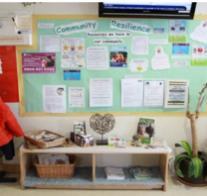Resilience Education Initiative
Published: 2 April 2018
The NCR part funded the post of Community Resilience Development Officer post at Education Scotland to work with the resilience community and teachers to embed resilience in the Curriculum for Excellence.
Case Study
Embedding Community Resilience—Development Officer, Resilient Individuals and Communities post
The National Centre for Resilience was one of several cross-sector partners who funded the 23 month secondment post of Development Officer, Resilient Individuals and Communities, hosted by Education Scotland. The purpose of this role was to help embed resilience thinking and online resources within the Curriculum for Excellence. The focus was to be on the causes of emergencies such as extreme weather, flooding and fire, the impact of these on communities and how young people can adapt and build resilience to reduce the impact.
The post was held by Alison MacLennon from Highland Council from March 2018.
|
Background/Context |
|
The post of Development Officer was created in 2013. At this stage it was funded by the Scottish Government Flood Management Unit and managed by a Steering Group—members included the Flood Management Unit, SEPA and Scottish Government Resilience Division. |
|
The post was extended following an independent evaluation carried out by CREW and a recommendation that the position should continue. |
The Project
The activities of this project were varied and far reaching, starting with the wide array of teaching resources which have been updated or created and made available via the Education Scotland community resilience landing page or on Ready Scotland. The resources include information on community resilience and the curriculum for excellence, learning journeys and accompanying activities for severe weather, case studies and resilience debating packs for Primary and Secondary school level.
While these resources will enable schools all across the country to get involved with community resilience, 15 schools, from all over Scotland, engaged directly with the project, becoming pathfinder schools. This included schools from the Highlands, Glasgow, East and West Lothian, North Ayrshire and Perth and Kinross.
The pathfinder schools all chose an area of resilience to focus on and incorporated learning and skills development in these areas in a variety of different ways. For example, Mintlaw Academy in Aberdeenshire held a ‘Beat the Flood’ activity with their S1 pupils, and Logie Primary in Moray, along with Unicef and the local Emergency Planning Officer, staged an emergency evacuation procedure helping to prepare pupils in case of a wild fire near their homes or school. Bun Sgoil Ghaidhlig Phort Righ have developed local partnerships with Police Scotland and a Gaelic liaison officer.
East Lothian Council worked closely with their local education departments to develop partnership working. As a result, various flood prevention programmes and opportunities are now available for schools within the local authority.

As well as direct engagement with schools this project was about encouraging the wider resilience sector to get involved with their local schools and educating them in how they might provide opportunities for school pupils to help them learn about resilience. Alison attended a variety of conferences and events to either present about the project and her role, or running workshops on the topic of resilience in education, such as at the 2018 Resilient Communities Conference at Cambuslang. At the same conference in 2019, Alison was joined by pupils from two pathfinder schools (Logie Primary School in Moray and Mintlaw Academy in Aberdeenshire) to present to the entire conference on the things they have learned about resilience and how they have been applying them in within their school lessons and extra-curricular activities. The presentations were really well received by delegates and the whole event was an exciting opportunity for the pupils, presenting to a large audience, but also getting to meet the people and services who could help them and their communities during an emergency.
Conclusions
Overall this project has increased school and pupil awareness and understanding of resilience, across Scotland. It has helped to engage pupils with resilience and what to do in the case of an emergency such as flooding or wild fire, but also personal and community resilience. Equally, it has encouraged local authorities and responders to consider how they might be able to work with schools and help to educate the next generation on what to do in an emergency and how to be more resilient.
The legacy of this project will not only be the resources and training that have been provided for teachers but also the valuable partnerships which continue to grow between schools and responders. Within the schools who actively engaged with the Development Officer and this project, the feedback has been that staff and pupils now feel more prepared against emergencies—thus the project has achieved its goal.
It is important to remember that the work carried out by the Development Officer and the schools she has worked with is just the beginning. Now that engagement has started and partnerships have been formed, it is for everyone to ensure that what has been learned continues to be applied, that the resources are used and that resilience appears on the curriculum in every school so that children and communities, and in turn responders, continue to benefit.
|
Key Points/Next Steps |
|
Pathfinder schools have identified their own resilience focus and created improvement plans inline with their own Local Authority format. |
|
Benchmarks for resilience have been developed for different curricular areas. All of the project resources are now being collated into a ’user friendly’ toolkit. |
|
Ready Scotland resources have been translated into Gaelic. |
|
A Community Resilience Film has been made by Bun Sgoil Ghàidhlig Phort Rìgh and will be publically released. |
First published: 2 April 2018

